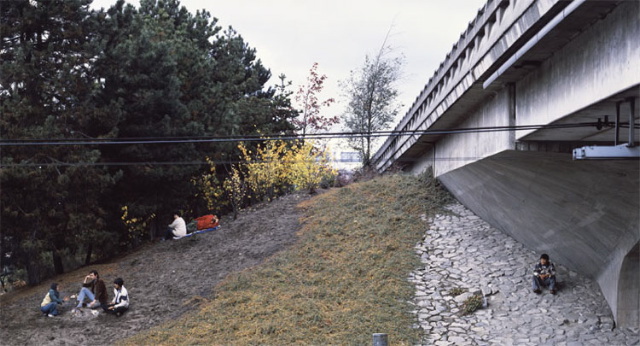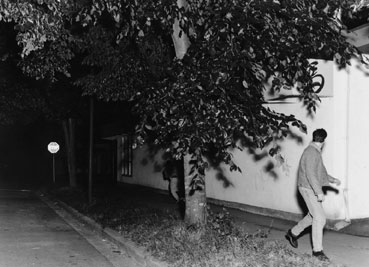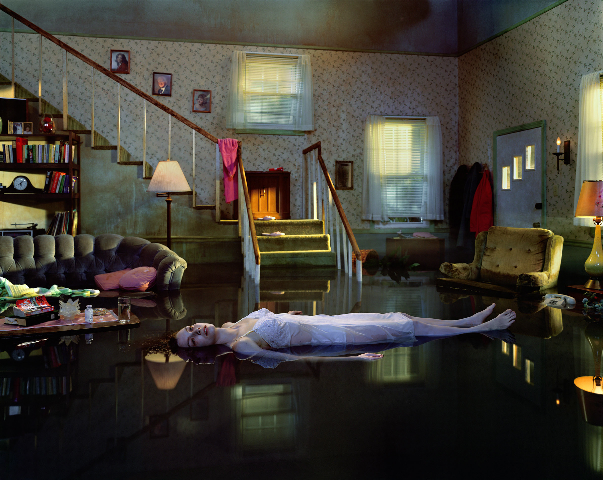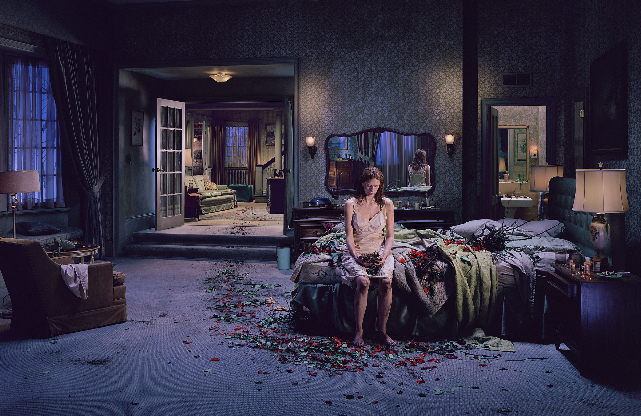By : Emese Krunak-Hajagos
Looking at the exhibitions of Contact always remind me of my childhood. My relationship with photography started at a very early age since my mother was a professional photographer. She had a portrait studio from the 1950th for 40 years in Budapest. Through her work staged photography filled my life and as a passionate reader I always connected stories to the photographs.
I always appreciated photographs that have been created through a long, meditated staging procedure and also have a strong narrative. There is of course a hard decision to make since every photograph is staged – even documentary – and all has a story to tell. In this article I will narrow my topic to analyzing two iconic contemporary artists Jeff Wall and Gregory Crewdson.

1/ Jeff Wall
The storyteller, 1986
Transparency in lightbox
229 x 437 cm
Courtesy of the artist
Looking at Wall’s and Crewdson’s life sized images we recognize immediately that these are not snapshots from the real world. By using the imagery and effects of paintings, movies and literature they create an invented world of make-believe. The two artists have many similarities in the procedure of creating their photographs, such as a long planning period, a complicated staging procedure and a very careful execution of the final image. Jeff Wall described this procedure in his interview Pictures like novels (db-artmag, 2007 May): “…when I work for a week on something, or a month, I do it because things change as I work. I discover things that I wouldn’t have known about the subject, about the place, about the time of day. Things I wouldn’t have known if I’d worked more quickly.” He rebuilds the original scene in his studio and recreates the significant moment that captured his attention, so it almost seems real. Crewdson’s pictures are much more complicated in their imagery and always have a dreamlike, almost supernatural present.

2/ Jeff Wall
Passerby, 1996
Silver gelatin print
250 x 339.5 cm
Courtesy of the artist
Both Wall and Crewdson are compared to the movies in the special way in which the photographs are made. They do not hide their staging and just like in the movies they are expensive and require a lot of planning, a big crew and special equipments. Wall’s stages are always realistic, regardless if they were built in his studio (Searching the premises, 2009) or he uses the outsides (Milk 1982, Passerby, 1996). Crewdson’s stages are closer to movie frames in their ambitions of picturing stills of strange stories or dreams. The perfection is so important for both artists that strong control must be applied. The images are planned in every detail and deliberately executed, so the camera only records what the artists want us to see and nothing more.
Wall hires amateur actors to represent his characters or people on the street (Waiting, War games) to play themselves. Crewdson went as far as engaging famous actors such us William H. Macy, Gwyneth Paltrow, Julianne Moore and Philip Seymour Hoffman to embody his protagonist (Dream House series, 2002) so their images from films blend with the scenes of domestic loneliness deepening the meaning of images.

3/ Gregory Crewdson
Untitled (Ophelia) 2001; From Twilight series
Digital C-print, 127 x 152.4 cm
© Gregory Crewdson. Courtesy Gagosian Gallery
Besides their similarities the two artists are very different in their narratives. Wall’s images are still closely related to the original moment he has witnessed. “I didn’t want to miss out on life”, he said in the same interview,” and so I involve this notion like a cinematographer, and I reconstruct. And the reconstruction is both; it’s as faithful to the event as I can make it. I feel I should be free to do things such as change the place, the season, the time of day.” He rebuilds the original scene in order to recreate the significant moment that captured his attention. He doesn’t add so much to the original scene but makes it really focused around the issue he wants to emphasize. For example in Mimic (1982), a street scene where a white man makes a racist gesture toward an oriental person by slanting his eyes might skip our attention but in Wall’s composition it is becoming a gigantic, painful episode impossible to overlook. He depicts the native people in Story telling (1986) in their effort of saving their heritage (a young woman wearing traditional clothes) and the danger of loosing it (the lonely rootless man under the bridge). He shows great sympathy towards the unemployed in Waiting. Wall’s picture radiates hope, he finds poor people interesting because their struggle deepens their expressions. Wall’s cinematographic photographs come into life only when the light switched on and the dark boxes start to radiate his images. At that magic moment they have a very strong present, representing the electric lights of cities and reminding us for our obsession with the always running television set.

4/ Gregory Crewdson
Untitled (Bed of Roses), Winter 2005; from Beneath the Roses series
Digital C-print, 163.2 x 239.4 cm
© Gregory Crewdson. Courtesy Gagosian Gallery
Crewdson has always been appreciated as one of the greatest artist of our time in depicting the modern American landscape, state of mind and psyche. Russell Banks writes is his forwarding words to Beneath the Roses series (2003-2005): “He is more a cartographer of the quotidian than a mere photographer, a cartographer of the specifically American quotidian, I should say, which is violent, melancholy, and corrosively lonely.” Crewdson’s scenes are typical American small towns, nicely maintained with well-lit streets, manicured gardens and all the houses filled with shining appliances. But in the backyard, under a bridge or in the quietness of a bedroom strange things are happening. Someone is digging out a number of suitcases without opening any, a woman turns a living room into a ruined garden and Ophelia quietly floats in front of a coach (Twilight series, 2001-2002). What has happened to the idyllic American dream? On these pictures it seems they turned into a nightmare. Is it a dream we see on the picture or is it real? Very hard to say since reality looks like a dream and dreams seem so real. Besides the strange staging and unnatural looking, frozen characters the use of light plays a key role in these photographs. Crewdson’s favorite time is twilight, the witching hour when everything stops for a moment and a strange metamorphosis takes place creating a very mystical image, making all vulnerable.
I clearly remember when critics were arguing if photography is an art form or mere technicality. Now critics think that it is not a good enough terminology for artist like Wall or Crewdson since as Martin Hochleitner wrote they “don’t take pictures, they make pictures.”

“Staged Photography | ARTORONTO” ended up being a beneficial posting.
If only there was a lot more weblogs such as this amazing
one on the web. Anyways, many thanks for your time, Lee